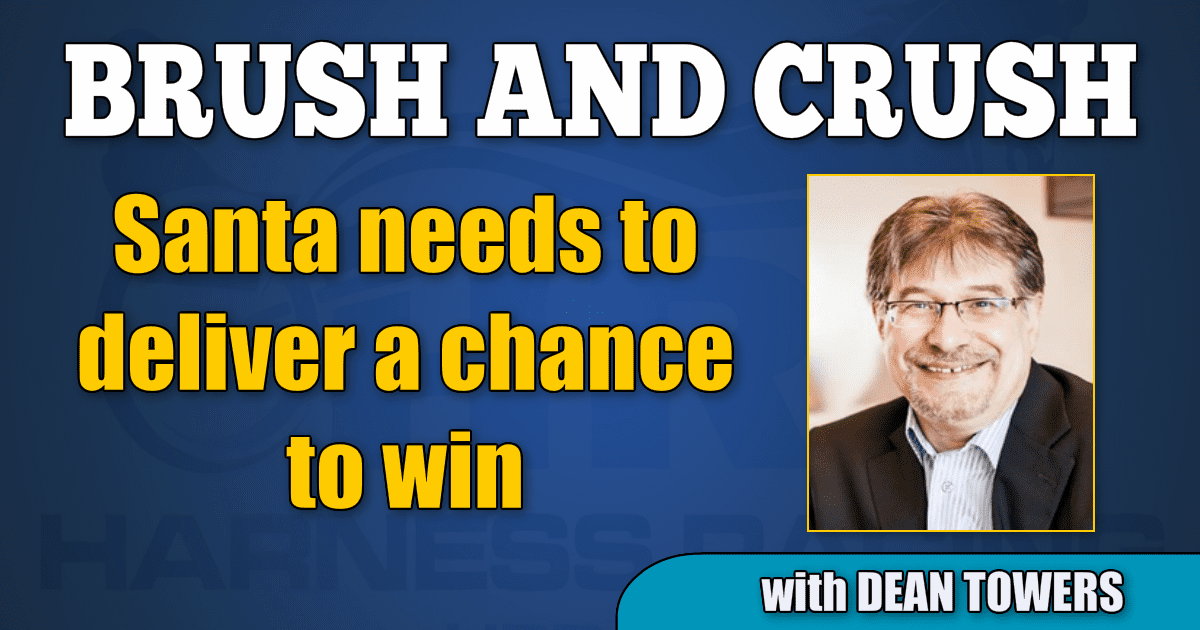
Santa needs to deliver a chance to win
by Dean Towers
What are you wishing for this Christmas?
Perhaps you’re hoping the yearling that has shown promise pans out; that your barn has some new powerful stock; that there’s extra cash in the stocking for stakes payments. Maybe you’re simply wishing for health and happiness. That’s a pretty good stand by.
For the good ship harness racing, we might wish for more slots, or better sports betting revenue, or some sort of big promotion that makes the sport more relevant again. Those things are all good.
But my wish for the sport is much more basic than that.
Back in 1962, a UCLA Ph.D. named Ed Thorp published a book called Beat the Dealer. He demonstrated that with perfect play (and a whole lot of smarts), blackjack could be beaten. Seasoned players read the book, studied the techniques and some did beat the game. Of course, this was offset by many others who flooded casinos and never did “beat the dealer”. In the process, blackjack exploded.
According to The Director of Gaming Research and UNLV lecturer David Schwartz, the game’s popularity since 1960 had nothing to do with “new layouts, attempts to make the game more social, or outreach to customers.” In fact, “antsy casino managers often made the game less welcoming.”
There were no bells and whistles, special deals, rebates, blockbuster fights or free room and drinks helping the game grow. Its explosion was all about a customer base realizing they had a chance to come out ahead.
Recently, this has not been the focus for the grand old game. Casino managers have made the game harder and harder to beat. They’ve whittled the player edge by over two per cent through hitting on 17, multiple shoes, and 6:5 blackjack. They hoped customers would not notice the difference, but they did. In Nevada, tables have fallen by 31 per cent, and revenue from blackjack is off an inflation-adjusted 46 per cent since 2000.
For harness customers reading this, I am sure you’re nodding your heads, because you know this tale all too well. The sport of racing, through intransigence, nickel and diming, and a bond of marriage to the status quo that would make the Father Knows Best demographic blush, has not delivered a chance to win. In fact, it’s been more difficult to win than ever. Players been living with shorter, less competitive fields, higher takeout, and fewer and fewer betting opportunities.
The betting customer base has seen the after races concerts and fireworks; the on-track promotions; the promise of slots and sports betting. Those things, like with blackjack, have not to helped them do what they want to do — bet horses with a chance to win.
So, what I hope Santa delivers harness this Christmas is simple. When the sport’s brain trust is about to make a decision that affects customers, I hope it begins to ask itself one question: “Will it help the customer win?”
When it asks what to do with a portion of slot money, or this half a million from sports betting, or this new subsidy that comes down the pike, the question should be: “Will it help the customer win?”
When discussing a new betting surcharge, or signal disruption, or change to the time off to qualify rule, or the protocol of a judges’ decision, it should ask: “Will it help the customer win?”
When the race office is putting a card together, or creating a new bet; when they’re deciding which races to make a part of the pick 4 or 5; when they’re devising a new stakes series, it should ask: “Will it help the customer win?”
A vibrant and healthy industry – any industry – exists when there are a great many people completing a great many transactions. To encourage transactional economies in harness racing, you have to encourage customers to bet. Helping bettors win is a big part of that, and it doesn’t take a professor and a popular book to help make it happen.













